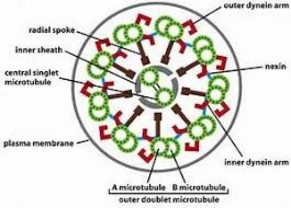Similar syndrome: Kartagener syndrome
Respiratory disease, generally of autosomal recessive transmission, associating a chronic bronchorrhea with bronchiectasis and chronic sinusitis.
Many mutations have been identified in 16 genes. These mutations cause an abnormality of structure or function of the cilia which can result in abnormal lateralisation of organs during embryogenesis (situs inversus for example) and abnormalities of the mobility of the cilia of the respiratory mucosa (and sperm flagella) producing chronic bronchorrhea with bronchiectasis and chronic sinusitis.
In cross section, each cilium (or axoneme) consists of nine pairs of microtubules assembled around a central pair. The nine pairs of microtubules are connected to each other by nexin and attached to the central pair: moreover, the outer dynein arms attached to the outer doublet microtubules are the motor structures of the cilium while the inner dynein arms are directed toward the center of the axoneme.

|
gene |
MIM |
site |
affected structure |
function |
association |
% of cases |
|
DNAI1 |
9p13-21 |
deficiency in outer dynein |
NO movement |
|
2-10 |
|
|
DNAH5 |
5p15 |
deficiency in outer dynein |
NO movement |
|
15-28 |
|
|
DNAH11 |
7p21 |
? |
hyperkinetic flapping |
|
6-9 |
|
|
TXNDC3 |
7p15 |
complete or partial deficiency in outer dynein |
mix of immobile and moving cilia |
|
rare |
|
|
RPGR |
Xp11-p21 |
complex anomalies |
NO movement |
pigmentary retinitis |
rare |
|
|
DNAI2 |
17q23 |
deficiency in outer dynein |
? |
|
2 |
|
|
KTU/ DNAAF2 |
14q21 |
deficiency in outer and inner dynein |
NO movement |
|
12 |
|
|
RSPH9 |
6p21 |
transduction of signals between the central pair and dynein |
rotational movements |
no abnormal laterality of organs |
rare |
|
|
RSPH4A |
6q22 |
no central pair of cilia |
rotational movements |
|
2-3 |
|
|
OFD1 |
Xp22 |
? |
disorganized movements |
mental retardation, craniofacial and fingers malformations, polycystic kidneys |
rare |
|
|
LLRC50/ DNAAF1 |
16q24 |
deficiency in inner and outer dynein |
NO movement |
|
4-5 |
|
|
CCDC39 |
3q26 |
deficiency in inner dynein and disorganized microtubules |
rapid beat pattern |
|
2-5 |
|
|
CCDC40 |
17q25 |
deficiency in inner dynein and bad positioning of the central pair |
rapid beat pattern |
|
3-8 |
|
|
DNAL1 |
14q24 |
deficiency in outer dynein |
reduction of the beat frequency |
|
rare |
|
|
DNAAF3 |
19q13 |
deficiency in inner and outer dynein |
NO movement |
|
rare |
|
|
CCDC103 |
17q12-q22 |
deficiency in inner dynein or complete or partial deficiency in outer dynein |
NO or reduced movements |
|
rare |
The prevalence is estimated at 1/16,000 but it is likely that cases are not diagnosed.
Clinically:
- unexplained respiratory distress
- cough, chronic bronchorrhea.
- bronchiectasis that appear in childhood, especially at the basal and the middle lobe
- chronic rhinitis with nasal polyposis (50%), frontal sinus agenesis and ear infections;
- sometimes associated with congenital heart disease (atrial septal defect, transposition of the great vessels).
According to the mutation, abnormalities at the level of other ciliated cells can be found: polycystic kidney disease or nephronophtisis, retinitis pigmentosa, sterility by immobility of sperm, Jeune's syndrome, Ellis van Creveld syndrome, Alstrom syndrome
In 50% of cases, there is situs inversus: referred to as Kartagener syndrome (see this topic).
Anesthetic implications :
risk of pulmonary complications (pre - and postoperative physiotherapy). Avoid nasal intubation. Be careful with pulmonary vasodilators which can inhibit reflex hypoxic vasoconstriction and thus induce or enhance hypoxemia (a case reported with oxytocin).
References:
- Tamalet A.
Dyskinésie ciliaire congénitale : qui et comment explorer ?
Arch Pédiatr 2011 ; 18 : 921-5.
- Ferkol TW, Leigh MW.
Ciliopathies : the central role of cilia in a spectrum of pediatric disorders.
J Pediatr 2012; 160:366-71.
- Boon M, Jorissen M, Proesmans M, De Boeck K.
Primary ciliary dyskinesia, an orphan disease.
Eur J Pediatr 2013; 172: 151-62.
- Nandhakular A, Silverman GL.
Acute hypoxemia in a parturient with primary ciliary dyskinesia following the administration of intravenous oxytocin : a case report.
Can J Anesth 2013; 60 : 1218-21.
Updated: August 2019